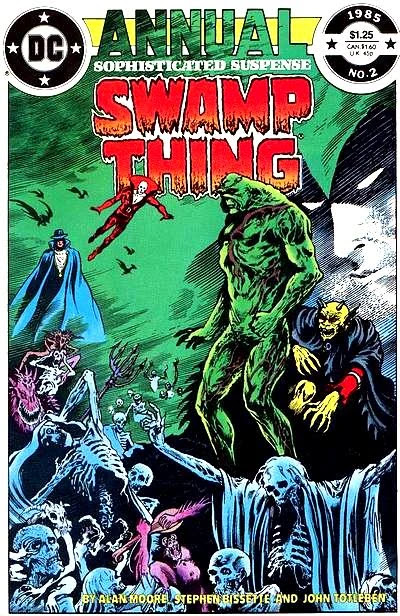No, Willie's inability to decide between Tessie and Millie was not a comment upon his sexuality.
Saturday, April 27, 2024
Friday, April 26, 2024
THE WEIRDIE FILES
DC jumped feet first into the supernatural/Gothic thing after having generally avoided that type of story for over 20 years, and it seems likely that Carmine Infantino was the biggest influence, as he himself claims in a JOURNAL interview:
I was trying to prepare for the inevitable. In my mind, “What if these things die? What if we’re back in the old days and suddenly superheroes drop off?” The reason I threw out a mess of different titles was, I wanted to sneak in The House of Mystery and The House of Secrets without people much realizing what was going on. Which I did. And also we had a chain of them out there, if you remember, and they were all successful before anyone at Marvel realized what was going on. So we had those going for us, and the superheroes going for us. Meanwhile I kept experimenting with different things.
Thursday, April 25, 2024
RAR #75: THE SHAMAN (1947)
In BLACKHAWK #17. The Blackhawks and their comrade Miss Fear take on The Shaman, who uses illicit atomic science to impress his native followers with his "magic." The location might be Canada, given that the only city mentioned is a made-up place called "North City." There's one line of dialogue where the White governor admits that the natives have some justice on their side, but that he doesn't like The Shaman's fear-mongering. Once he's out of the way, of course, everything becomes hunky-dory.
BTW, despite the judgment rendered by Chuck, there's clearly nothing "dirty" about the Shaman's counter. Olaf comes at the Shaman clumsily, and the Shaman uses his own momentum against him. Later, of course, Olaf does win the second and last bout, but only because he's better prepared. If one of the Blackhawks had used judo against a larger enemy, then that would have been "smart."
Thursday, April 18, 2024
THE WEIRDIE FILES
Though Alan Moore wasn't the first writer to convoke weirdies, he was one of the guys who made the trope popular.
In SWAMP THING ANNUAL #2. for instance, the titular muck monster has to journey to Hell to save the spirit of Abby Arcane, and he gets the assistance of a former ally, The Demon, in so doing. Moore manages to work in Deadman, The Spectre and the Phantom Stranger, even though none of them are necessary to the plot.
In contrast, Moore's almost-final SWAMP THING story guest-stars all of the above weirdies, plus Doctor Fate and many others, and they are all necessary to the plot, so maybe he used the Annual to re-familiarize his readers with DC's resident weirdies just so they wouldn't seem yanked in out of nowhere.
Tuesday, April 16, 2024
THE WEIRDIE FILES
Here's a prominent example of a convocation of weirdies with no monster content, the so-called "Trenchcoat Brigade" from THE BOOKS OF MAGIC.
Monday, April 15, 2024
THE WEIRDIE FILES
Technically the story "Brothers" crosses over Brother Power with a couple of Swamp Thing's support characters, but it counts.
A cool cover to a boring story in SPECTRE #11, featuring stature-characters Spectre, Doctor Fate, Phantom Stranger, Madame Xanadu, Deadman, and The Enchantress, and one charisma-character, The Gentleman Ghost.
THE WEIRDIE FILES
In keeping with my new determination of "weirdies" as a subcategory of crossovers, THE WEIRDIE FILES are dedicated to this literary phenomenon.
I'll start with the most recent iteration of JUSTICE LEAGUE DARK.
The superordinate ensemble is made up of Wonder Woman, Zatanna, Swamp Thing, Man-Bat, and Detective Chimp.
The subordinate ensemble consists of The Demon, John Constantine, Blue Devil, and the late great Zatara.
Subordinate guest stars with stature include Zauriel, Deadman, Phantom Stranger, Madame Xanadu, Andrew Bennett, and five Justice Leaguers. A few such characters show up for one panel and have no lines.
Subordinate guest stars possessed of only charisma are Traci Thirteen, Klarion the Witch Boy, Morgaine LeFey. Felix Faust, Nabu the Wise, Mordru, and the demonic trio Ghast, Rath, and Abnegazar. Traci, daughter of the ghost-buster Doctor Thirteen, attained a little stature in the backup series ARCHITECTS AND MORTALITY but I'm not sure it's consequential enough to designate her a stature-type.
Sunday, April 7, 2024
CROSSOVER MADNESS
Woody Woodpecker started out as a proto-crossover, popping up in the Andy Panda cartoon KNOCK KNOCK in 1940, and quickly eclipsing all the other characters in the Walter Lantz studio.
For years to come Lantz would continue having his characters cross over in comics and cartoons. FOUR COLOR COMICS #21 is devoted to Oswald Rabbit and his friends, and Woody appears just for about three or four pages, just because.











